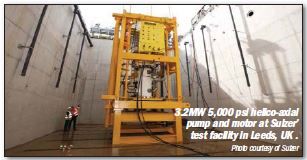Pumps in Subsea Processing
PUMP TECHNOLOGY IS LEADING THE WAY IN THE DEPLOYMENT OF TURBOMACHINERY ON THE OCEAN FLOOR
The boosting, separation and compression technology used in subsea processing has been proven to increase production rates. Now these methods are propelling subsea processing into more extreme areas such as the Arctic.
The Research Partnership to Secure Energy for America (RPSEA) has calculated that in a typical field in the Gulf of Mexico, producers might expect to naturally recover seven to ten percent of the total hydrocarbons present, without the benefit of any subsea processing. By installing a boosting pump, however, that rate of recovery can potentially double, and with subsea water injection, recovery can increase by another seven percent.
This applies to greenfield as well as brownfield projects. In brownfields, for example, the remaining reservoir pressure makes it a challenge to be able to flow hydrocarbons to the production facility. Similarly, greenfield reservoirs can be under-pressured or have more challenging reservoir and fluid properties. In these cases, it becomes necessary to improve on natural recovery rates.
While subsea processing is important in improving recovery rates and overall profitability, it is increasingly becoming an economic enabler. A project would not go ahead without the presence of subsea processing.
An ongoing development program promises to eliminate surface platforms in oil and gas operations. The plan is to replace them with subsea equipment (see the Cover Story). To making this platformless vision a reality, cost-efficient, reliable subsea processing systems are being deployed to the sea floor.
This is enabled through reliable technology which requires minimal maintenance. Additionally, the development of pumping systems that allow for greater operational flexibility is providing operators with options that translate into the ability to produce more hydrocarbons from their existing fields.

3.2 MW 5,000 psi helico-axial pump and motor at Sulzer' test facility in Leeds, UK.[/caption]
In partnership with Sulzer, FMC Technologies has combined multiphase pump hydraulics and a 3.2 MW, 6,000 rpm permanent magnet motor for subsea boosting applications that meet these requirements.
The technology uses helico-axial pump hydraulics based on multiphase pumping experience in topside applications. It is capable of boosting production fluids with high gas volume fractions (GVFs) up to 100%. For lower GVF applications, the helico-axial pump stages can be combined ahead of traditional centrifugal stages, forming a hybrid pump to provide a high boost pump.
The permanent magnet synchronous motor with its rotor and large rotor-stator air gap — integral to the qualified pump design — presents improvements over conventional induction motor-driven pumps. Combining a stiff rotor design with a fully contained permanent magnet rotor using a carbon-fiber sleeve allows operating speeds of up to 6,000 rpm.
In high GVF applications, this technology enables differential pressure two to three times higher than an induction motor operating at 4,000 rpm. Additionally, it raises pump flexibility.
Sealed cable-wound stator and carbon-sleeve rotor designs allow for the use of water-based barrier fluid suitable for Arctic fields. Long step-out applications which require step-up, step-down transformers have been fully qualified for permanent magnet motor operation.
The initial 3.2 MW pump product is being followed by a 6 MW, 15,000 psi, 6,000 rpm pump. This new design simplifies subsea power distribution, using fewer mechanical interfaces and reducing the umbilical costs. This pump system also promises increased drawdown for high GVF applications while still delivering high pressure rise.